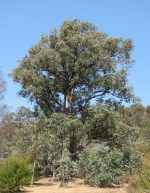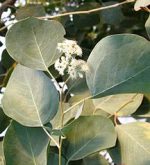 Also called Australian beech and red box, this small to medium evergreen tree is native to southeastern Australia and is a member of the myrtle family, Myrtaceae, that also includes guave, bay rum tree, and clove. It grows up to 75′ tall and has fibrous mottled bark and fragrant gray-green leaves that are up to 3″ long and are round or oval when young but lance-shape and up to 4.3″ long when mature. In spring to summer, clusters of 7 off-white flowers appear at the ends of branchlets but are not ornamentally significant. They give way to woody, barrel-shapped to conical fruit capsules that are about 1/4″ long. The trees are popular street trees and shade trees, and used as windbreaks. The young leaves are often used in dried arrangements. The genus name, Eucalyptus, is from the Greek eu meaning well, and kalypto, meaning to cover, and refers to the lid formed by the united calyx-lobes and petals covering the inner parts of the flower before it opens. The specific epithet, polyanthemos, comes from the Greek poly- meaning many, and anthemon, meaning flower.
Also called Australian beech and red box, this small to medium evergreen tree is native to southeastern Australia and is a member of the myrtle family, Myrtaceae, that also includes guave, bay rum tree, and clove. It grows up to 75′ tall and has fibrous mottled bark and fragrant gray-green leaves that are up to 3″ long and are round or oval when young but lance-shape and up to 4.3″ long when mature. In spring to summer, clusters of 7 off-white flowers appear at the ends of branchlets but are not ornamentally significant. They give way to woody, barrel-shapped to conical fruit capsules that are about 1/4″ long. The trees are popular street trees and shade trees, and used as windbreaks. The young leaves are often used in dried arrangements. The genus name, Eucalyptus, is from the Greek eu meaning well, and kalypto, meaning to cover, and refers to the lid formed by the united calyx-lobes and petals covering the inner parts of the flower before it opens. The specific epithet, polyanthemos, comes from the Greek poly- meaning many, and anthemon, meaning flower.
 Type: Evergreen tree
Type: Evergreen tree
Outstanding Feature: Foliage
Form: Rounded
Growth Rate: Rapid
Bloom: Clusters of small off-white flowers in spring to summer
Size: 30-75′ H x 15-45′ W
Light: Full sun
Soil: Average, dry to moist, well-drained; tolerate flooding and drought.
Hardiness: Zones 9-10
Care: Prune from spring to late summer to shape and maintain good crotych angles.
Pests and Diseases: Susceptible to beetle borers, Armillaria and root rot.
Propagation: Seed
Outstanding Selections:
Photo Credits:Wikipedia